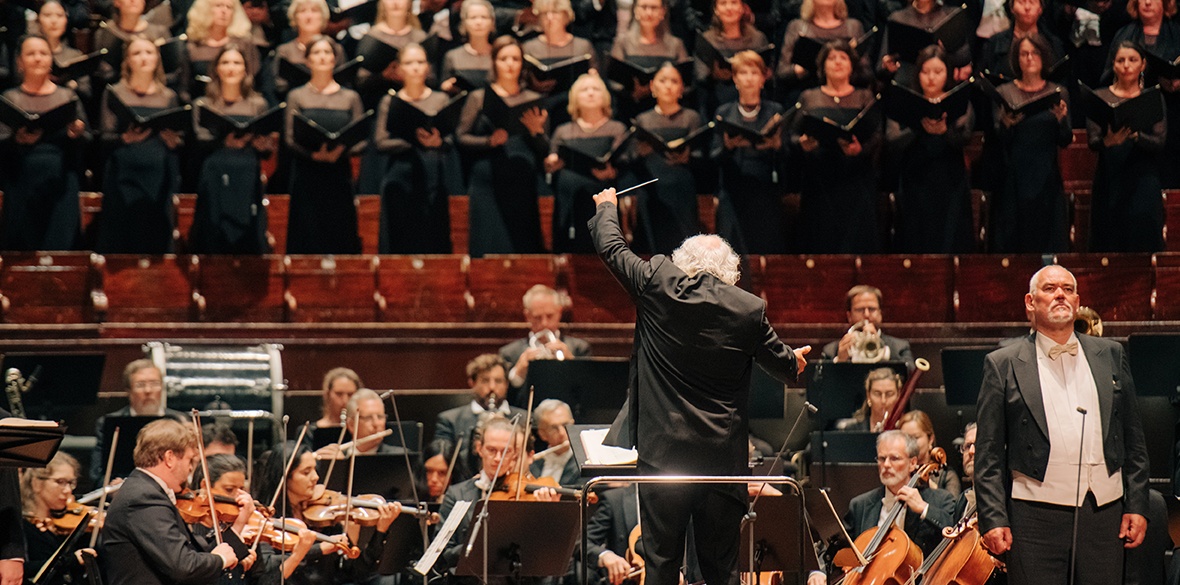This is the last article you can read this month
You can read more article this month
You can read more articles this month
Sorry your limit is up for this month
Reset on:
Please help support the Morning Star by subscribing here
TANNHAUSER ★★★★★, performed by the mighty forces of Deutsche Oper Berlin under the baton of Scotland’s own Sir Donald Runnicles, was my first ever experience of Wagner: a four-hour-long concert performance, without scenery.
And for a thing like that, you do your homework.
We discover the troubadour Tannhauser sated, in the realm of forbidden sexual excess, and eager to leave. His erstwhile competitors in song welcome him back and are challenged to “reveal the true nature of love” to a courtly audience.
They are so shocked by his sensuality that he is dispatched to the Pope to beg forgiveness. The Pope refuses and Tannhauser disappears back to the grotto of Venus, never to be seen again.
Is it surprising that gay men have adored this opera for nearly two centuries?
Wagner adds a redemptive woman and changes the end. She is smitten by Tannhauser, and dies. Tannhauser dies as well and perhaps his soul is saved. Or not.
What is certain is that this opera, along with the Flying Dutchman and Lohengrin, established Wager as a master in the portrayal of emotions, orchestration and thematic handling, and changed Western classical music.
No-one had ever done this before with such narrative skill, and to hear it was to become completely involved in the music in a way unlike all the other concerts I have reviewed. It grips you and the hours fly past. Not a moment of picture-making is wasted.
But it was an odd experience. In my mind I saw a tiny toy theatre with card figures on wires, like a precocious child’s dramatisation of a storybook. This seems to be Wagner’s innocent genius: to tell a story — any story! — in a toy theatre.
This childhood aesthetic is illustrated in immense detail, but it is still a childhood aesthetic, and a way to contain the world. A miniaturisation.
You can see why the populists fall for it. Any political power would want such an accessible and absorbing art form on its side.
But the infantility of the aesthetic means that there are limits. The orgies of Venus are off-stage and only suggested, and I was surprised (and disappointed) by the pallour of the post-coital mood in which the thing kicks off.
It was as though Wagner knows his audience to be puritanical about sex, (even if they are also repressed and obsessed with it) and it is from that frustration that he fashions the whole thing.
It is, in other words, entertaining because full of conflict, but not liberating. It is about restraint and punishment, and this conservative ethos allows Wagner to perfect the musical means by which he tells the story.
Call me naive, but these were the first impressions of a Wagner virgin. A revelation to me, and not something you can perceive without experiencing a live performance of the highest quality.
Wagner comes, of course, with that painful anti-semitic baggage, and this must have weighed on Gustav Mahler who followed him.
Aged 15, the aspiring Jewish composer sought Wagner out personally on a visit to Vienna, and Mahler’s symphonic work is regarded correctly as extending the “maximalisation” of the sonorous and temporal elements of Wagner’s compositional style.
So, his first symphony begins with a chord seven octaves wide, between the highest notes of the violins and the lowest of the double bass, and into this sonic daybreak he inscribes snatches of birdsong and the appearance of dance, of people moving in rhythm.
But unlike Wagner, you hear subversive snatches of Kletzmer alongside the stomping polkas and trumpets.
This was played by the Simon Bolivar Symphony Orchestra of Venezuela HHHHI under Gustavo Dudamel, the ensemble that sprang from the 50-year-old initiative in music education called “El Sistema.”
This is funding for music education that doesnt come from the culture budget, but from social services, and whose activities were 100 per cent funded by Hugo Chavez in 1998 for the first time.
And the orchestra is composed of people from poor backgrounds who have come through “El Sistema.” Astonishing, really.
They are slick and dramatic, but so eager to please and put on a show that the music itself disappears behind the glossy sheen of entertainment.
This performance may come from Caracas, but it belongs in the Disney concert hall in Los Angeles where Dudamel himself leads the Los Angeles Philharmonic.
The concert included two Venezuelan compositions. First was the knotty counter-rhythmic jungle of Paul Desenne’s Guasamacabre, which the composer claims reflects the economic and constitutional crisis of 2017. A tough, impenetrable piece.
Next was Gonzalo Grau’s Concerto for Cuatro and Orchestra that mines the Venezualan ukelele for contemporary classical ends.
It was interesting and virtuosic, but you can’t help feeling that this is a version of “latinism” that is acceptable to US audiences. There’s no revolutionary song. There’s no squeak of “Hasta siempre, Commandante.”
It’s not that the Venezuelan “right to culture” enshrined in Chavez’s constitution is not a marvellous initiative, or that the politics of El Sistema are not basically sound; it’s what purpose that culture is being put to.
When the orchestra puts on Venezuelan colours to play an encore from West Side Story, Leonard Bernstein’s caricature of Latin communities in the US, you feel that a tactical opportunism underlies their musical choices. Have they always been like this, or are they going stale?
The Communist Party of Venezuela has criticised the policies of Nicolas Maduro’s government, accusing them of excessive influence by the US.
Politically and economically this may or may not be correct, but it was, for sure, an appropriate way to criticise the music on display in Edinburgh.











